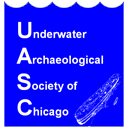Underwater Archaeological Society Of Chicago
Meeting Minutes
February 22, 2017
President Dean Nolan greeted 23 members and guests.
Videos of winter on Lake Michigan were shown by Jim Jarecki before the start of the meeting.
Minutes were available on the table. There was no treasurer’s report. Dean reminded us to pay dues.
Illinois Council of Skin and Scuba Divers –The Underwater Competition is coming up on March 19 and there will be a raffle. There was low attendance at the Club Appreciation night. Chuck said that the Council needs someone to do an underwater video and Al volunteered.
Our World Underwater –Volunteers are needed to staff the booth; a sign in sheet was passed around.
Nautical Archaeological Society –Dave Thompson will be coming in the last week of April to give a course on Underwater Archaeological Illustration on April 29th. (Jim added that the Oriental Institute also gives a land based class $30.) Dean needs to know how many members will be taking the NAS course.
The dive coordinator was not present.
Website –Colin Bertling said that we now have a meet-up group where we can post. It will provide numerous automatic reminder and rsvp possibilities. There is not much activity on the Facebook page.
Diving –We will probably dive the Mystery Wreck , also known as Eric's Wreck, to continue the NAS course when Dave Thompson comes in late July.
Ghost Ships –The booth was already reserved for March 10-11 and volunteers are needed to man it.
Sam Polonetsky wished everyone Happy National Engineers’Week.
Upcoming Speakers: March-- Taras Lyssenko will speak about shipwrecks located in Illinois which he found while doing recoveries for A&T. April –Ted Karamanski’s topic will be the history of Great Lakes navigation and lighthouses. May - Robert Kurson, who wrote Shadow Divers and Pirate Hunters and discovered the German submarine in the Great Lakes, will be the presenter. June -- Kevin McGee, the assistant director of Cleveland Underwater Explorers and who will be at OWU, will talk about the Argo and Anthony Wayne wrecks.
UASC short program presenters will be: March—Carol Sommers, Red Sea wrecks, April –Colin Bertling, Wells Burt Shipwreck, May –Al Potelli (who may send a presentation in the dropbox), June --Chuck and Margo Miller, the Mac, July—Bob Rushman, the Buccaneer, August-- someone is needed, September—Tony Keifer, October—Jim Jarecki, how tonnage is measured, and October—Paul Ehorn, Great Lakes diving pioneers.
Member program: Don Smith spoke about and showed videos of the EB Morgan shipwreck near Winnetka. The 143-foot long, 310 ton, three-masted lumber barge was built in 1847and was named after Edwin Barber Morgan who was from an influential family. There was a crew of nineteen. It had a series of misfortunes, some of which follow: 1851 –ran aground by Chicago, 1856 –stuck on St. Clair flats and collided with another ship, 1858- stuck in sand by Chicago, 1864-- ran ashore 5 miles north of Evanston, and was wrecked after being in such a bad storm that the captain had his wife and baby tied to the mast to save them. Everyone was safely brought to shore one by one by the use of a life buoy. The wreck is located 150 yards off-shore and two miles south of Lloyd Ramp in only 12 to15 feet of water. On occasion sand covers it up and UASC has never surveyed it. To do so, it would be necessary to carry one’s gear in and go out before May because otherwise it is a public beach where a daily fee has to be paid. There’s also a bluff to deal with. Don added that he is researching another wreck south of it believed to be the Winslow which sunk in 1841. The lumber trade was booming in the 1870’s and 80’s and many ships sailed along the shore with lumber. They often tried to do one last trip in the fall and would run to shore if there was a storm in order to save the cargo.
Featured speaker: Richard Lanyon, who worked for the Metropolitan Water and Reclamation District of Greater Chicago for fifty years and retired as its executive director, spoke about his book, Draining Chicago. The sewage and rainwater treatment system in Chicago is considered one of the seven engineering wonders of the world. The original street level of Chicago was Wacker Drive and sewage drained into Lake Michigan. From 1855 to 1889 the size of the city quadrupled and the Sanitary District was created. After 1907 no more sewage was allowed in the lake. The reversal of the Chicago River was possible in part because we have a subcontinental divide into which it drains. The north branch of the river which was a meandering stream with a floodplain was straightened by including already dug quarries. These had contained clay which was used to make bricks. The extension of the channel up to the northern suburbs enabled them to send sewage south for treatment. To build the channel, dredges, steam shovels and even hand power were used, the latter as when shafts were excavated to bedrock for a road bridge. When constructing sewer tunnels, workers carved out the moist soft clay by hand. There are several treatment plants, with the one in Stickney being the largest. Aeration tanks are used so that existing naturally-occurring bacteria eat up waste. Most pumping stations are the original ones, from the 20’s and 30’s and machinery can pull water in different directions so that flood water can go into the lake on the north side if necessary. Ultraviolet tubes are used to kill bacteria at some plants. The entire system of man-made canals is 77.1 miles. The Deep Tunnel is located 200 to 300 feet deep and there are shafts which allow excess water to drop down.
As a coincidence, the Chicago Scuba Meet-up will have a tour of the Stickney Plant on March 15.
Minutes respectfully submitted by Carol Sommers
